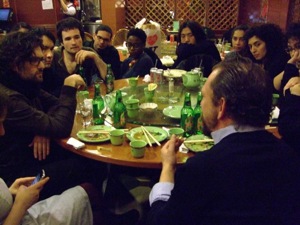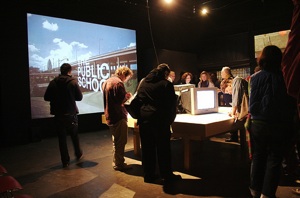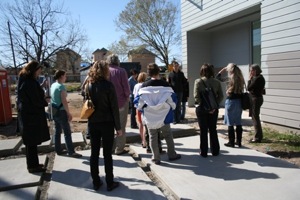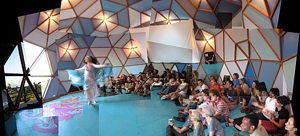In
the September 13, 2009 edition of The New York Times, art critic Roberta Smith lamented the
“academicization of the art world” (see Artists Without Mortarboards) and, went as far as to write that
the growing interest among art schools in offering Ph.D.s in art “makes the
blood run cold.” However, what warmed Smith’s cockles was the Bruce High
Quality Foundation University, a newly launched insurgent, artist-run school
that “is being made up as it goes along.”
On
the very same page of the paper, art critic Holland Cotter wondered if
contemporary art had forgotten how to “establish a perch for truly independent
thinking outside the larger culture, including its own larger culture” (see Top of the Wish List: No More Blockbusters). Enter the proliferation of
genre-busting, open source, non-accredited artist-run schools, that take
education outside the rarified, privileged spaces of institutions and into
social spaces. Whether intended as a critique of art schools, a form of
education as exhibition (as put forth by Anton Vidokle, the headmaster of
temporary art schools), as micro-utopias, or to democratize art education,
these truly independent “art schools” continue to emerge and appear to have
reached, dare I say, a movement? Compiled here is a user’s guide to some recent
temporary, itinerant, non-accredited art schools.
Bruce High Quality Foundation University (New York) Opened on September 11, 2009, “BHQFU is a progressive practical research
university invested in the manipulation of the histories that inform artistic
practice. BHQFU is a radical educational experiment incorporating classes,
pedagogical videos, performance lectures, exhibitions, and street actions.”
The Independent School of Art
(San Francisco) The Independent School of Art was a project lead by artist Jon Rubin that existed the Bay Area from
2005-2007 as “an experimental art school that autonomously operated without
external resources, accreditation, or a physical site.” Tuition for the school
was on a barter system, which underscored “the social contract between students
and teachers and honored their collective labor.” The ISA’s intentional
homelessness emphasized the school’s preference for social over physical
architecture. Gatherings took place in living rooms, parks, swimming pools
(with the class in the water), empty classrooms, galleries, and vacant
storefronts.
Manifesta
6 Biennial (proposed
location: Nicosia, Cyprus) Intended
as an international, independent, interdisciplinary art school, based on the
model of Black Mountain College, the organizers of Manifesta 6 put out a call
for participating faculty and students, and began to generate a freeform
temporary institution. Despite the fact that this school was never actually in
session (the plug was pulled before its opening in 2006 by the host city of
Nicosia, Cyprus for reasons to be deciphered here), the discourse that Manifesta 6 generated
has become source material for other artist-run schools. Notes
for An Art School, with essays by Manifesta 6 organizers Florian
Waldvogel, Mai Abu ElDahab, and Anton Vidokle, is essential reading for anyone
interested in this subject.
Night School (New York) Offered by The
New Museum from 2008-2009, The Night School was conceived of by Anton Vidokle
as an artist project in the form of a temporary school. Twelve seminars and
workshops were taught by impressive faculty, including Paul Chan, Okwui
Enwezor, Liam Gillick, Maria Lind, Martha Rosler, and Rirkrit Tiravanija. In
the tradition of free universities, many of Night School’s events were open to
anyone interested, however, a core group of 25 “students” were selected by
application and expected to engage in more intense participation at all the
Night School’s events.
Pickpocket Almanac (San Francisco) Established in September 2009 with
SFMoMA as an online/offline school, “Pickpocket Almanack is an experimental
school without walls. Each season, under the direction of independent curator
Joseph del Pesco , a temporary faculty comprised of artists, designers, writers,
and filmmakers creates theme-based courses by selecting from a diverse series
of scheduled public Bay Area events, including lectures, screenings, workshops,
and panels. Faculty for the fall season includes Les Blank, Jens Hoffmann, Ben
Kinmont, Beth Lisick, and Rick and Megan Prelinger.”
The
Public School (Los Angeles) An offshoot of the Los Angeles arts organization, Telic Arts
Exchange, The Public School was
begun by Fiona Whitton and Sean
Dockray in 2008, and produces curriculum based on community-demand. Subjects
may be proposed by anyone, and if enough people show interest (by signing up),
the school finds a teacher, and a course on that subject ensues. Current
curriculum at The Public School includes, “Economies of Attention: Media
Technology and Biopolitics” proposed by “caleb waldorf”, and taught by Kenneth
Rogers; “Canning, Pickling, and Preserving” proposed by “cybelle”, and taught
by Paul Pescador; and “Performance / Performativity / Enactment” proposed by
“liz_gL”, and taught by Liz Glynn.
Saturday
Free School for the Arts
(Houston) A project of Houston’s own
Skydive, Saturday Free School for the Arts was started in
2009 as a means to offer “skillshares, lectures, and workshops” at no cost to
the general public. Offerings have ranged from “How to Look at Rock Videos as
Art” taught by curator Bill Arning to “Copoeira Instructor Shows Basics” taught
by Mauricio Campos. To contextualize the efforts of the school, Skydive
co-founder Sasha Dela gave a talk at Contemporary Arts Museum Houston on
September 5, 2009 titled “Learn About Free Schools.” Admission was, you guessed
it, free!
Sundown
Salon cum Sundown Schoolhouse (Los Angeles) Artist Fritz Haeg’s informal art gatherings
(begun in 2001 as “Sundown Salons”) at his geodesic dome home in Los Angeles
gradually grew to be one of the most varied independent art schools of them
all, including “events, happenings, gatherings, meetings, pageantry,
performances, shows, stunts and spectacles.” A brand new limited edition book
by Evil Twin Publications, The Sundown Salon Unfolding Archive, chronicles the venue’s events
from 2001-2006. Since 2006, the school was renamed as “Sundown Schoolhouse”
with a more formalized schedule and set of curriculum.
unitednationsplaza (Berlin) After his disappointment with the cancellation of Manifesta 6, Anton
Vidokle, founded unitednationsplaza. “Structured as a seminar/residency program
in the city of Berlin from 2006-2007, unitednationsplaza involved collaboration
with more then 100 artists, writers, theorists and a wide range of audiences.”
All unitednationsplaza events were free and open to the general public, and a
second unitednationsplaza, centered around “the possibilities for artistic
agency today,” took place in Mexico in 2008.
Utopia Station (Venice) Curated for the 50th Venice Biennale in 2003 by
Molly Nesbit, Hans-Ulrich Obrist, Rirkrit Tiravanija, Utopia Station was not a
school per say, but rather a participatory platform for “performances,
concerts, lectures, readings, film programs, and parties.” Despite criticisms
of being separate from the Biennale and looking like the location of
yesterday’s blowout party, Utopia Station set the stage for the explosion of
itinerant art schools and their curriculum to come.
Further
reading, class:
Precedents: Bauhaus, Black Mountain College , Gordon Matta-Clark
and Caroline Gooden’s Food. Context: Modern Painters (Rethinking Art Education, Fall 2006). Related Exhibitions: Lessons from Below: Otabenga Jones & Associates at The Menil Collection (September 14–December 9,
2007).









1 comment
desperate?